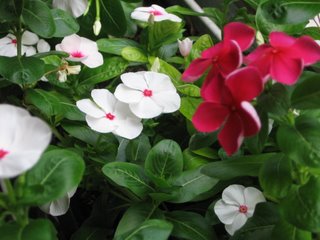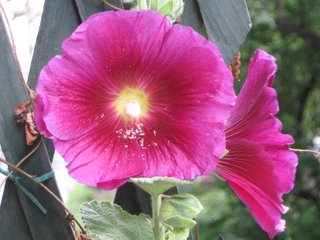skip to main |
skip to sidebar
I love periwinkles and nearly always have some of them on the balcony in July and August. Their name comes from the Russian apparently – pervinka, meaning first flower. That presumably refers to the little blue creeping ones, Vinca minor. The ones I use, Vinca Rosea, appear in our local garden centre at the beginning of July. They don’t seem to get attacked by pests and diseases and are great for filling in holes left in containers because other things have died. This year though I’ve put them all together, and they’re just a mass of flowers.
 But although they’re easy to maintain, I don’t find them easy to grow. I tried again this year using seeds from last years flowers, but failed miserably. The book said to sow in March at about 20° and keep them in the dark for three weeks. That meant in the house, as the temperature outside in March is nowhere near that – especially this year, when we had a long cold winter. So they lived under the bed for a while, but to no avail. It may have been the seed or the method, I’m not sure. I’ll try again next year.
But although they’re easy to maintain, I don’t find them easy to grow. I tried again this year using seeds from last years flowers, but failed miserably. The book said to sow in March at about 20° and keep them in the dark for three weeks. That meant in the house, as the temperature outside in March is nowhere near that – especially this year, when we had a long cold winter. So they lived under the bed for a while, but to no avail. It may have been the seed or the method, I’m not sure. I’ll try again next year.
Another “bought” success this year has been my yellow surfinia. I saw it in a roadside florist’s kiosk and couldn’t resist. I’d heard they were delicate, so didn’t have very high hopes, but it’s been wonderful. It’s quadrupled in size and has flowered non-stop, so I’ve spent half the  summer dead-heading. I usually prefer ordinary petunias to surfinia, as I’ve found them a bit straggly in the past, but this one is so bushy that I’ve had to change its position – at the beginning I had it on the inside of the balcony, but after a few weeks could hardly get past it. So it’s now trailing over the balustrade. The only thing I hate about it is that, like all petunias, it’s incredibly sticky. The grower who manages to develop a non-sticky petunia is set to make a fortune ….
summer dead-heading. I usually prefer ordinary petunias to surfinia, as I’ve found them a bit straggly in the past, but this one is so bushy that I’ve had to change its position – at the beginning I had it on the inside of the balcony, but after a few weeks could hardly get past it. So it’s now trailing over the balustrade. The only thing I hate about it is that, like all petunias, it’s incredibly sticky. The grower who manages to develop a non-sticky petunia is set to make a fortune ….
 But let’s start with the successes … This year I’ve been really proud of my zinnias and my hollyhocks. The zinnias came from seeds taken from one small plant which I bought last year, and have done extremely well. Our conditions suit them down to the ground – hot sun, limy water... I also tried a trick I’d read about in one of my gardening books – peanut shells in the earth to aerate the soil and provide a gradual, non-nitrogen rich fertiliser. It seems to have worked.
But let’s start with the successes … This year I’ve been really proud of my zinnias and my hollyhocks. The zinnias came from seeds taken from one small plant which I bought last year, and have done extremely well. Our conditions suit them down to the ground – hot sun, limy water... I also tried a trick I’d read about in one of my gardening books – peanut shells in the earth to aerate the soil and provide a gradual, non-nitrogen rich fertiliser. It seems to have worked.
I was also really pleased with my Hollyhocks. They were an experiment as I got the seeds from England and wasn’t sure if they’d take kindly to being pot bound, or to the temperatures here. But they’ve been wonderful. I had three – pale lemon, pale pink and a wonderful colour which isn’t mauve, isn’t purple, isn’t red and isn’t pink, but is somehow all of those rolled into one. They’ve been flowering for weeks, and though they’re now past their best are still forming buds. They lost a few lower leaves to red spider mite early on in the year, but since I dealt with that haven’t had a single problem. I'd never seen hollyhocks in Milan before I planted mine, but this year there’s been a glorious display of them growing along the tram lines near Piazza Cinque Giornate. There’s no way they could have got there by chance – someone wanting to brighten up the city must have scattered the seeds. And they were wonderful –about 30 of them in every colour you could imagine. Some of their seeds are now germinating on my back balcony ….
I'd never seen hollyhocks in Milan before I planted mine, but this year there’s been a glorious display of them growing along the tram lines near Piazza Cinque Giornate. There’s no way they could have got there by chance – someone wanting to brighten up the city must have scattered the seeds. And they were wonderful –about 30 of them in every colour you could imagine. Some of their seeds are now germinating on my back balcony ….
Gardening without a garden is not easy ....Firstly, lack of space. Where do you put your seeds and your cuttings? If you want to grow bulbs, biennuals and perennials where do you put the plants which aren't in flower to make space for those which are? And when you've finally got every inch crammed with plants, how do you get a chair in so you can sit and enjoy them?Secondly, the position of the sun. I have an east facing balcony and a west facing balcony, so the plants on each only ever receive light from one direction and inevitably all end up craning desperately away from the house. Containers can be turned around of course, but this can be difficult if you have trailing plants which are just too big to have on the inside of an average sized balcony - mine is only about a metre across. The amount of sun is also a problem. My balconies are each out of direct sunlight for twenty two hours out of every twenty four, as there are other tall buildings on both sides. But when the sun does hit, the balconies are a sun trap. We're in Italy and in the afternoon on the west facing balcony, the temperature can soar for a short period to over 55°C. The balcony sides are opaque glass, and plants can easily scorch.Then, there's the lack of rain. This not only means that everything has to be watered by hand, with tap water that has an extremely high calcium content, but also that leaves don't get washed naturally. They get dusty and grimy (Milan is not renowned for its clean air) and need cleaning so they can breathe. And pests which love dry conditions, such as red spider mite, have a field day. (If you stick with me, you'll hear a lot more about red spider mite).If you're a balcony gardener, you'll probably be able to add to the list. Gardening books don't seem to help much - they seem to ignore the specific problems and presume you're content to buy pre-grown plants from the garden centre at the beginning of the season and throw them away at the end. Or more likely in the middle when they're attacked by insects, or mould or whatever. Pretty maybe, but it destroys most of the fun. So, here's the alternative guide to balcony gardening - problems, solutions, successes and failures. Usually mostly failures, to be honest. But probably some other quirky stuff in between. And photos - if I can ever find out how to put them on ....
 But although they’re easy to maintain, I don’t find them easy to grow. I tried again this year using seeds from last years flowers, but failed miserably. The book said to sow in March at about 20° and keep them in the dark for three weeks. That meant in the house, as the temperature outside in March is nowhere near that – especially this year, when we had a long cold winter. So they lived under the bed for a while, but to no avail. It may have been the seed or the method, I’m not sure. I’ll try again next year.
But although they’re easy to maintain, I don’t find them easy to grow. I tried again this year using seeds from last years flowers, but failed miserably. The book said to sow in March at about 20° and keep them in the dark for three weeks. That meant in the house, as the temperature outside in March is nowhere near that – especially this year, when we had a long cold winter. So they lived under the bed for a while, but to no avail. It may have been the seed or the method, I’m not sure. I’ll try again next year. summer dead-heading. I usually prefer ordinary petunias to surfinia, as I’ve found them a bit straggly in the past, but this one is so bushy that I’ve had to change its position – at the beginning I had it on the inside of the balcony, but after a few weeks could hardly get past it. So it’s now trailing over the balustrade. The only thing I hate about it is that, like all petunias, it’s incredibly sticky. The grower who manages to develop a non-sticky petunia is set to make a fortune ….
summer dead-heading. I usually prefer ordinary petunias to surfinia, as I’ve found them a bit straggly in the past, but this one is so bushy that I’ve had to change its position – at the beginning I had it on the inside of the balcony, but after a few weeks could hardly get past it. So it’s now trailing over the balustrade. The only thing I hate about it is that, like all petunias, it’s incredibly sticky. The grower who manages to develop a non-sticky petunia is set to make a fortune ….





